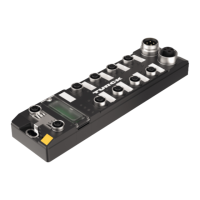Parameterizing and Configuring
IO-Link functions for acyclic communication
120
Hans Turck GmbH & Co. KG | T +49 208 4952-0 | F +49 208 4952-264 | more@turck.com | www.turck.com
9.1.2 PROFINET parameters
For PROFINET, a distinction must be made in the parameters between the PROFINET device
parameters and the parameters of the I/O channels Parameters_TBEN_S2-4IOL .
PROFINET device parameters
Default values are shown in bold.
Parameter name Value Meaning Description
Output behavior at
communication loss
0 set to 0
The device switches the outputs to
"0". No error information sent.
1 Hold current value The device maintains the actual out-
put data.
Deactivate all dia-
gnostics
0 No
Diagnostic and alarm messages are
generated.
1 yes Diagnostic and alarm messages are
suppressed.
Deactivate load
voltage diagnostics
0 No
The monitoring of voltage V2 is activ-
ated.
1 yes If V2 is undershot, this is not dis-
played.
Deactivate I/O-ASSIST-
ANT Force Mode Deac-
tivate Force Mode
0 No
Explicit deactivation of the Ethernet
protocols or web server
1 yes
Deactivate
EtherNet/IP™
0 No
1 yes
Deactivate Modbus
TCP
0 No
1 yes
Deactivate WEB server
0 No
1 yes
9.2 IO-Link functions for acyclic communication
The acyclic access to the data of IO-Link devices is realized via IO-Link CALLs. A distinction must
be made between data of the IO-Link master (IOLM) and data of connected IO-Link devices
(IOLD).
The addressing of the IO-Link CALL defines which device is addressed via the CALL:
The addressing is defined by the so called Entitiy_Port:
n Entity_Port 0 = IO-Link master module (IOLM)
n Entity_Port 1 = IO-Link device at IO-Link port 1
n …
n Entity_Port 8 = IO-Link device at IO-Link port 8

